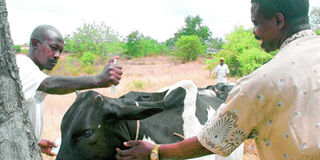Why your animals should sleep under mosquito nets

A veterinary official treats a cow in Kwale. Rift valley fever is prevalent during and after heavy rainfall as floods and stagnant waters provide suitable breeding grounds for different species of mosquitoes that spread the disease. FILE PHOTO | NMG
What you need to know:
- The disease is prevalent during and after heavy rainfall as floods and stagnant waters provide suitable breeding grounds for different species of mosquitoes that spread the disease to other mosquitoes, animals and humans.
- Veterinarians, farmers, abattoir workers etc are particularly at higher risk of infection with the virus.
- There is no specific treatment for Rift valley fever in animals and human.
- People must avoid eating meat from animals known to have been sick before slaughter.
Rift Valley Fever is a fever causing viral zoonosis that primarily affects ruminant animals such as cattle, buffalos, sheep, goats that also infects humans and can cause illness.
The virus was first identified in Kenya in the early 1900’s as veterinarians investigated an outbreak of a mysterious disease that had infected sheep on a farm along the shores of Lake Naivasha in the Rift Valley region.
The disease is prevalent during and after heavy rainfall as floods and stagnant waters provide suitable breeding grounds for different species of mosquitoes that spread the disease to other mosquitoes, animals and humans.
Mosquito eggs can survive for prolonged periods (years) in drought and hatch during rainfall or floods.
The disease is transmitted through:
• Bites from infected female mosquitoes,
• Contact with body fluids and organs of an infected animal (during slaughter, when a vet is assisting an infected cow give birth, when handling aborted foetuses, when doing post mortem etc).
• Through inhalation during the slaughter of infected animals.
• Ingestion of unpasteurized or raw milk.
It follows therefore that Veterinarians, farmers, abattoir workers etc are particularly at higher risk of infection with the virus. The virus shows the following clinical signs in animals:
• Fever of up to 42°C
• Nasal discharge
• Increased salivation
• Loss of appetite
• Bloody diarrhoea
• Abdominal pain
• Respiratory distress
• Weakness
• Abortion storms in pregnant animals
• Death
In humans the following clinical signs may be seen:
• Flu-like symptoms
• Blurred and decreased vision
• Inflammation of the brain, which can lead to headaches, coma, or seizures
• Vomiting blood
• Bloody stool
• Bleeding from gums, skin, nose, and injection sites
In human, these symptoms may appear for 2-4 days and death could occur 3-6 days thereafter.
Treatment
There is no specific treatment for Rift valley fever in animals and human. Most human cases of RVF are mild and self-limiting. Management of the rare, but serious cases are generally limited to supportive care.
Any animals showing signs of the disease should be reported to the nearest Veterinary Office.
Prevention and Control
• There exists a vaccine against RVF in animals in areas where the disease is endemic.
• Control of mosquitos and other blood sucking insect populations is necessary to prevent the spread of the disease. Protecting against bites from mosquitoes and other bloodsucking insects by use of mosquito repellents and bed nets.
• A person’s chances of becoming infected can be reduced by taking measures to decrease contact with blood, body fluids, or tissues of infected animals through use of personal protection equipment (gloves, surgical masks, etc.) when working with potentially infected animals.
• Ensuring that all animals are inspected by a veterinarian before slaughter and that sick are not slaughtered.
• Ensure one does not eat meat from dead animals.
Other than the dreaded rabies disease, a number of zoonoses including RVF remain important to animal health professionals, farmers, meat inspectors and the general Public.
RVF must be borne in mind especially so when dealing with cases of high fever in ruminants. RVF is potentially much more important today especially following the recent floods witnessed across the country.
People must avoid eating meat from animals known to have been sick before slaughter.





